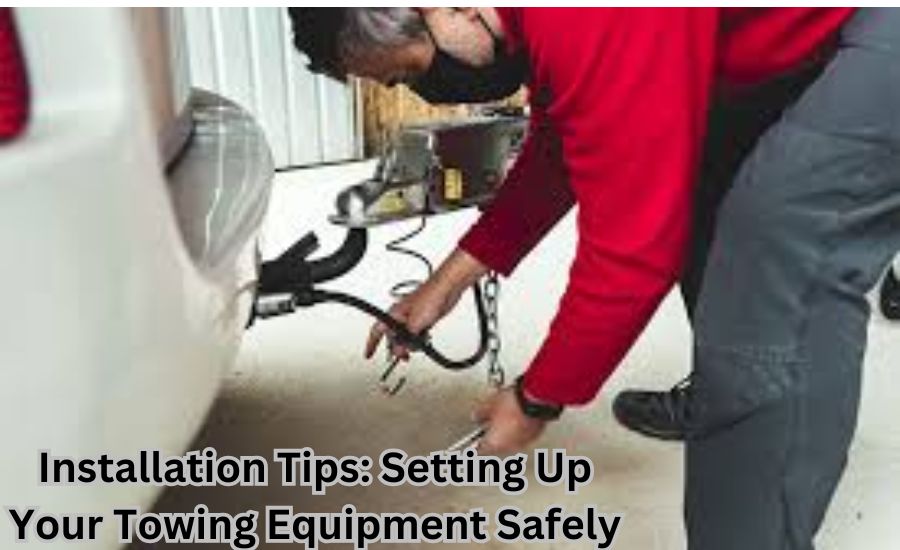When it comes to safe and effective towing, understanding allinurl: automotive towing equipment hitches balls is crucial. Whether you’re planning to tow a boat, trailer, or camper, selecting the right hitch and ball combination can significantly impact your towing experience. In this guide, we’ll explore everything you need to know about towing equipment, focusing on hitches and balls to help you make informed decisions.
Towing can seem overwhelming at first, but it’s about matching the right components to your vehicle and load. Each piece of equipment, from the hitch receiver to the trailer ball, plays an essential role in ensuring your setup is secure. By the end of this article, you’ll be well-equipped to choose the best towing equipment for your needs and drive confidently on your adventures.
Understanding the Basics of Towing Equipment
Towing is a way to pull something behind your vehicle, such as a trailer, boat, or other heavy objects. To do this safely, you need to understand the basics of automotive towing equipment hitches balls. The main components include the hitch, ball mount, trailer ball, and coupler. Each part plays a crucial role in ensuring that your towing setup is secure and effective.
The hitch is a strong metal piece that is attached to the rear of your vehicle. It holds everything together, allowing you to connect the trailer safely. There are various types of hitches, including receiver hitches and fifth-wheel hitches, each designed for different towing needs. The ball mount connects the hitch to the trailer and provides a platform for the trailer ball. The trailer ball is the rounded piece that the trailer connects to, while the coupler is part of the trailer that locks onto the ball.
Understanding how these parts work together is vital for safe towing. Properly matching each component ensures that your vehicle can handle the weight and type of trailer you plan to tow. Additionally, keeping your towing equipment in good condition and knowing how to use it will help prevent accidents and injuries. Remember, safety is the priority when towing anything behind your vehicle.
Exploring Different Types of Hitches and Their Uses
When it comes to towing, not all hitches are created equal. Understanding the various types of hitches and their specific uses is crucial for selecting the right one for your needs.
Receiver Hitches
Receiver hitches are among the most common types of hitches and are widely used for smaller trailers, bike racks, and cargo carriers. They consist of a square receiver tube that attaches to the rear of your vehicle. Receiver hitches come in different classes, which indicate the maximum weight they can handle.
- Class I Hitches: These are designed for lighter loads, typically rated for up to 2,000 pounds of gross trailer weight (GTW).
- Class II Hitches: Suitable for slightly heavier loads, with a capacity of up to 3,500 pounds GTW.
- Class III and IV Hitches: These hitches are robust and can handle loads between 4,000 and 10,000 pounds, making them suitable for larger trailers.
Receiver hitches are often adjustable and can be found on many vehicles, making them a popular choice for casual towing.
Fifth-Wheel Hitches
Fifth-wheel hitches are specifically designed for larger trailers, such as RVs or campers. They attach to the bed of a truck, which provides a more stable connection compared to a standard hitch.
- Stability: Fifth-wheel hitches distribute weight more evenly, reducing the chances of swaying during travel.
- Towing Capacity: These hitches generally have higher weight ratings, often exceeding 20,000 pounds GTW, making them ideal for heavy-duty towing.
The design allows for tight turns and maneuverability, which is beneficial when towing larger trailers over long distances.
Fifth-wheel hitches are designed for larger trailers, like RVs or campers. They attach to the bed of a truck, which provides a more stable connection compared to a standard hitch. This stability is essential when towing heavy loads over long distances. Gooseneck hitches are similar to fifth-wheel hitches but are typically used for heavy-duty loads like horse trailers. They allow for tight turning and better weight distribution, which is beneficial for managing larger trailers. Knowing which hitch to use based on your towing needs is crucial for a successful towing experience.
How to Choose the Right Hitch Ball: Size and Weight Capacity
Choosing the right hitch ball is an important aspect of towing safely. Hitch balls come in different sizes: 1-7/8 inches, 2 inches, and 2-5/16 inches. To find the right size, check the trailer’s coupler, which is where the ball fits. It’s important to ensure the ball fits snugly into the coupler. If the ball is too small, it won’t connect properly. If it’s too big, it can be dangerous and lead to accidents.
In addition to size, you also need to consider the weight capacity of the hitch ball. Each ball has a maximum weight it can handle, which is typically marked on the ball itself. Always check the weight of your trailer and make sure the hitch ball can support it. A mismatch in weight capacity can cause the ball to fail while towing, leading to potential accidents.
It’s also wise to consider the weight of any cargo you may add to your trailer. The combined weight of the trailer and its load should not exceed the hitch ball’s rated capacity. If you regularly tow different trailers, it might be worth investing in a set of hitch balls of various sizes and capacities to ensure you’re prepared for any situation.
Matching Your Towing Setup: Ensuring Compatibility with Automotive Towing Equipment Hitches Balls
Ensuring compatibility in your towing setup is crucial for safe towing. Each component, from hitches to balls, must work together effectively.
Understanding Weight Ratings
- Hitch Rating: Check the maximum weight capacity of your hitch to match the trailer weight.
- Ball Rating: Select a hitch ball that meets or exceeds the trailer’s weight for safe towing.
Hitch and Ball Size Compatibility
- Ball Size: Choose between 1-7/8 inches, 2 inches, and 2-5/16 inches to fit your trailer coupler snugly.
- Mounting Heights: Ensure the hitch ball height aligns with your trailer’s coupler for optimal performance.
Vehicle Towing Capacity
- Check the Manual: Determine your vehicle’s maximum towing capacity from the owner’s manual.
- Consider Payload: Include the weight of cargo in the trailer when assessing total weight.
You May Also Like: WNFLB
Installation Tips: Setting Up Your Towing Equipment Safely

Proper installation of your towing equipment is essential for safety on the road. Start by carefully following the manufacturer’s instructions when setting up your hitch. Make sure the hitch receiver is tightly attached to your vehicle. All bolts should be secured to the recommended tightness to prevent any loosening during travel.
When you attach the hitch ball, ensure it’s locked in place securely. It’s vital to check that the ball mount is correctly inserted into the hitch receiver. Before you start driving, double-check all connections to confirm they are secure. A proper installation can prevent accidents and keep you safe while towing.
Another important tip is to verify the height of your hitch. The height should be level with the trailer’s coupler when the trailer is loaded. If the hitch is too high or too low, it can lead to swaying and instability while driving. Adjusting the height properly ensures a smoother and safer towing experience.
Maintenance and Inspection: Keeping Your Towing Gear in Top Shape
Taking care of your towing equipment is essential for safe and reliable use. Regular inspections should be part of your routine maintenance. Check your hitch and hitch ball for any signs of wear and tear, such as rust, cracks, or bending. If you find any damage, it’s best to replace those parts before towing again.
Before each trip, inspect all connections to ensure they are secure. It’s also a good idea to lubricate the moving parts, such as the ball mount, to prevent wear. Keeping your towing gear in top shape will extend its lifespan and ensure it works effectively.
Additionally, consider keeping a maintenance log for your towing equipment. This can help you track inspections, repairs, and replacements over time. Knowing the condition of your gear will help you catch potential issues before they become serious problems.
Common Towing Mistakes to Avoid
When towing, it’s important to be aware of common mistakes that can lead to accidents or damage. Here are some pitfalls to avoid:
- Exceeding Weight Limits: Always check your vehicle’s towing capacity and the trailer’s weight. Exceeding these limits can cause brake failure and handling issues.
- Improper Hitch Installation: Ensure that your hitch is installed correctly. A loose or improperly attached hitch can disconnect while driving.
- Neglecting Safety Chains: Always use safety chains. They provide an extra layer of security and prevent the trailer from detaching completely if the hitch fails.
- Ignoring Load Distribution: Balance the load in your trailer. Uneven distribution can lead to swaying and loss of control.
- Not Performing Regular Inspections: Regularly check your towing equipment for wear and tear. Look for cracks, rust, or loose parts that could compromise safety.
- Driving Too Fast: Reduce your speed when towing. Increased stopping distance and trailer sway are common with higher speeds.
- Failing to Adjust Mirrors: Make sure your mirrors are adjusted properly to ensure clear visibility of the trailer and surrounding traffic.
- Skipping Maintenance: Regularly maintain your towing equipment, including checking the brakes, tires, and lights on both the vehicle and trailer.
- Not Using the Right Gear: Make sure to use the correct hitch ball size and type for your trailer. Mismatches can lead to unsafe conditions.
Safety First: Best Practices for Towing
When towing, safety should always come first. Ensure your equipment is in good condition and installed properly. Use your vehicle’s mirrors to get a clear view of your trailer, and always use turn signals when changing lanes. This will help other drivers understand your intentions on the road.
It’s also important to drive at a safe speed when towing. Towing can make your vehicle harder to control, so it’s best to stick to lower speed limits. Many states have specific towing speed limits, so be aware of these rules. Practicing your braking techniques is essential; you’ll need to account for the extra weight when coming to a stop.
Additionally, consider taking a towing safety course. These courses can provide valuable tips and techniques for handling your vehicle and trailer safely. Following these best practices will help you have a successful and safe towing experience.
The Importance of Weight Distribution in Towing

Weight distribution plays a crucial role in the stability and safety of your towing setup. Proper distribution can make a significant difference in how well your vehicle and trailer perform together. Here are key points to consider:
- Balanced Load: Ensure that the load in your trailer is evenly distributed from front to back and side to side. An unbalanced load can cause swaying and affect steering.
- Weight Toward the Front: Aim to place approximately 60% of the trailer’s weight at the front and 40% at the back. This helps maintain stability while towing.
- Avoid Overloading: Do not exceed your vehicle’s towing capacity. Overloading can lead to decreased braking efficiency and increased wear on your vehicle.
- Check Axle Ratings: Ensure that the weight on each axle of the trailer does not exceed its rating. This helps prevent tire blowouts and axle failure.
- Use a Weight Distribution Hitch: Consider using a weight distribution hitch if you’re towing heavier loads. This type of hitch helps distribute weight evenly across your vehicle and trailer, improving handling and stability.
- Regularly Inspect Load: Before you start your journey, inspect your load to ensure it hasn’t shifted. Make adjustments if necessary to maintain proper distribution.
- Re-evaluate After Loading: After loading your trailer, take it for a short drive and assess how it handles. Make any necessary adjustments to the load distribution for optimal performance.
Choosing Between Fixed and Adjustable Hitches: Pros and Cons
When picking a hitch, you have to decide between fixed and adjustable options. Fixed hitches are simple and very strong, making them good for regular towing needs. They are often easier to install and usually less expensive than adjustable models.
However, adjustable hitches offer more flexibility for different towing situations. With adjustable hitches, you can change the height depending on the type of trailer you are towing. This is particularly useful if you have multiple trailers with different coupler heights. While they can be pricier and a bit more complex to install, the versatility they offer can be well worth the investment for frequent users.
Deciding between the two depends on your towing needs. If you regularly tow different trailers, an adjustable hitch might be the best choice. On the other hand, if you have a specific trailer that you use consistently, a fixed hitch could be sufficient. Understanding the pros and cons of each will help you make the right decision.
Conclusion
In conclusion, understanding automotive towing equipment hitches balls is essential for safe towing. From knowing the components of your towing setup to selecting the right hitch and ball, every aspect plays a role in ensuring a safe and effective towing experience.
Regular maintenance, proper installation, and adhering to best practices can significantly reduce the risk of accidents on the road. Remember to always check your vehicle’s capacity, distribute your load evenly, and drive with caution. By following these guidelines and understanding the importance of each component, you can navigate the world of towing with confidence.
Get the Latest Updates On LiveMintPro
FAQS
Q: What is the best type of hitch for light towing?
A: For light towing, a Class I or Class II receiver hitch is ideal. These hitches are designed for smaller trailers and lightweight loads, making them easy to use for everyday towing needs.
Q: How do I know the correct hitch ball size for my trailer?
A: To find the correct hitch ball size, check your trailer’s specifications. Common sizes include 1-7/8 inches for lightweight trailers, 2 inches for medium loads, and 2-5/16 inches for heavy trailers.
Q: What should I do if my trailer sways while towing?
A: If your trailer sways, stop safely and check the load distribution. Make sure the weight is balanced and consider using a weight distribution hitch to improve stability.
Q: How often should I inspect my towing equipment?
A: It’s recommended to inspect your towing equipment before each trip. Check for wear and tear on the hitch, ball mount, and safety chains to ensure everything is secure and functioning properly.
Q: Are safety chains necessary when towing?
A: Yes, safety chains are essential. They provide a backup connection between your vehicle and trailer in case the hitch fails, adding an extra layer of safety while towing.
Q: Can I tow more than my vehicle’s rated capacity?
A: No, you should never exceed your vehicle’s rated towing capacity. Doing so can damage your vehicle, create unsafe driving conditions, and lead to accidents.





